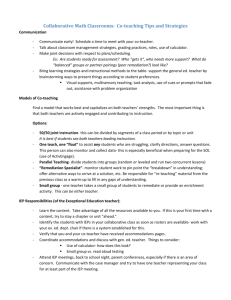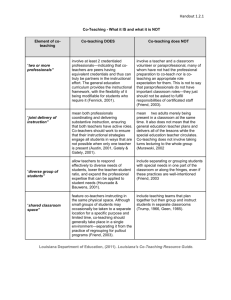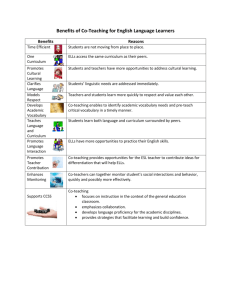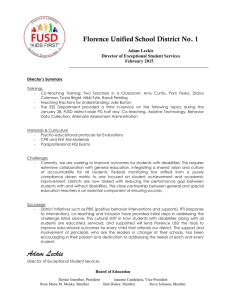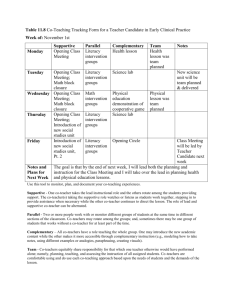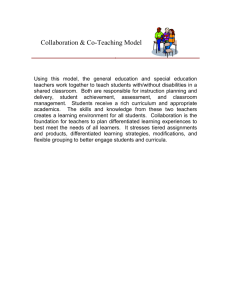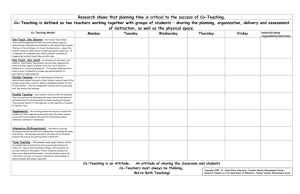Essential Components for Planning Effective Co-teaching
advertisement
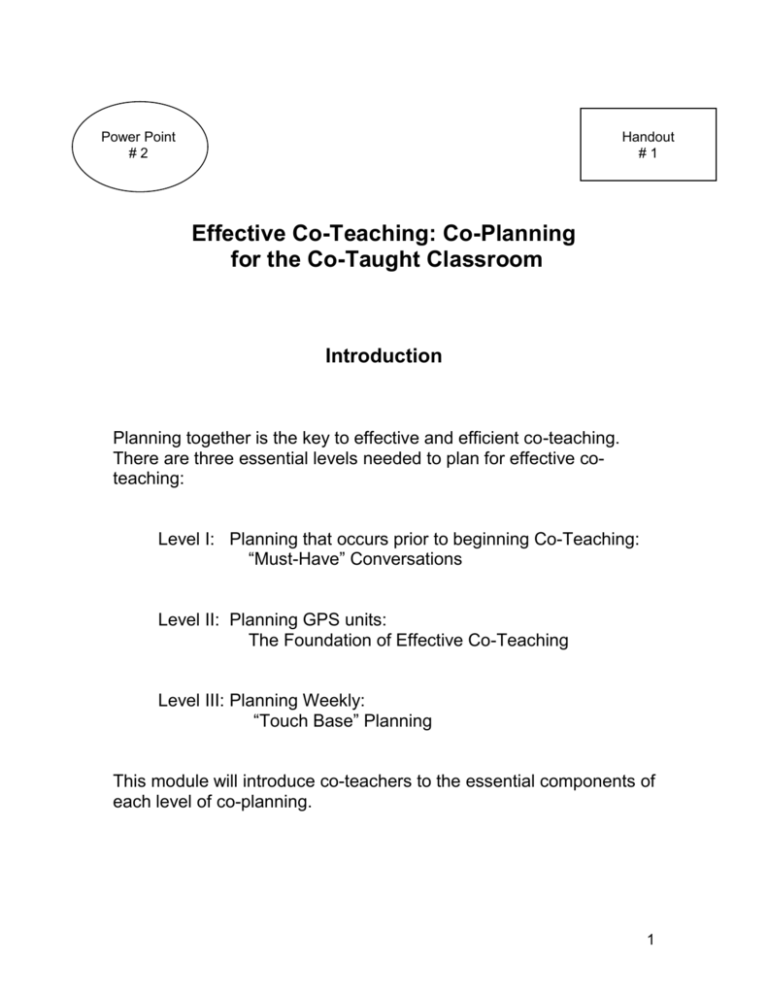
Power Point #2 Handout #1 Effective Co-Teaching: Co-Planning for the Co-Taught Classroom Introduction Planning together is the key to effective and efficient co-teaching. There are three essential levels needed to plan for effective coteaching: Level I: Planning that occurs prior to beginning Co-Teaching: “Must-Have” Conversations Level II: Planning GPS units: The Foundation of Effective Co-Teaching Level III: Planning Weekly: “Touch Base” Planning This module will introduce co-teachers to the essential components of each level of co-planning. 1 Power Point #3 Handout #2 Level I: Planning Prior to Beginning Co-Teaching The first level of planning should take place prior to the beginning of the school year or semester for the new co-teaching team. However, in the “real” world, if a team has started to co-teach, this planning should take place as soon as possible. Level I planning is designed to give co-teachers an opportunity to create a vision of how the cotaught class will be managed. Level I planning requires co-teaches to engage in “must-have” conversations to start the dialogue about the various aspects of classroom instruction, management, environment and learning profiles of students with disabilities (Wilson, 2006). Wilson suggests that the teachers continue to use the phrase “must-have” to communicate to their co-teacher that a discussion is needed to reflect upon or revisit a classroom procedure/issue. Example of “must-have” conversation: Teacher 1 allows students to go to the restroom after the agreed upon 3 passes have been used by the student. Teacher 2 asks teacher 1 for a “must-have” to open the dialogue about this student and the procedure that had been agreed upon. Based on years of training and experience working with co-teachers, the Center for Collaborative Education at Georgia State University suggest that Level I planning needs to be at least a half day (4 hours) or multiple sessions to establish the management and instructional needs for the co-taught class. Remember the “ideal” time is prior to the beginning of co-teaching. This type of planning also can be used prior to the implementation of the Supportive Instruction model, to communicate the expectations of the teacher to the paraprofessional, interpreter, or other personnel for the inclusion classroom. Handout 2 lists the “must have” conversations in a checklist format to guide co-teachers in their conversations. 2 Handout #2 Power Point #4 “Must-Have” Conversations 1. Parity/Equality and Space: These two issues are paramount in relaying the message to students that there are two certified teachers for this classroom and both teachers will be responsible for the learning of all students. It is important that teachers do not imply with subtle behaviors that there is one teacher and an assistant in the class. Example of parity/equality and space in the co-taught classroom: If teacher 1 has to ask teacher 2 where the pencils are kept, this sends the message that teacher 2 “owns” this classroom and must be the “real” teacher. Activity Allow teachers two minutes to discuss with their co-teacher how they plan to demonstrate parity/equality and what suggestions can they make to plan for two teachers in the classroom environment. Have a few teams share their suggestions. Possible examples: Both names on the door Both names on all correspondence Introduce each other on the first day of class (use a power point slide to make it personal) Share the one desk Move in a second desk Use a table to be the shared space Both have designated file drawer space and cabinet space 3 Power Point #5 Handout #2 2. Professional Behavior: Professional behavior can often be a point of tension for co-teachers. Both teachers should be on time and stay the entire time the class is scheduled. This is not a time for a teacher to leave the class while another certified teacher covers the class. Certainly, there will be exceptions to this, but the expectation is that both teachers will be providing instruction and addressing classroom behavior. Power Point #6 Handout #2 3. Instructional Routines: In the co-taught classroom it is important that both teachers establish instructional routines for the class. The co-teachers should decide what general instructional procedures will be utilized in the classroom for learning activities. Activity Allow co-teachers the time to talk about how they establish instructional routines for their classes and ask them to decide on the general procedures for the instruction. Ask several teams to share out loud any new ideas for routines that were discussed with their coteacher. 4 Power Point #7 Handout #2 4. Organizational Routines: In addition to instructional routines, classrooms need procedures to manage students. These routines should be introduced on the very first day and posted in the class as reminders for all students. Posting the procedures is a great way for teachers to use a pointing gesture instead of a full-blown conversation repeatedly with some students. This is especially helpful in managing students with behavior disorders or ADHD, and it also is an effective tool for supporting all students. Examples to support organizational procedures: Allowing students to have input into determining procedures Using 3 passes per semester for leaving the room to attend to personal needs Earning points for being prepared Rewarding students for having homework on random days Accepting makeup work, but grading it lower 5 Power Point #8 Handout #2 5. Behavior Management: The classroom behavior management plan is critical to support the efficient and effective co-teaching classroom. It should be detailed and reviewed with students several times at the beginning of the year. The plan must be implemented consistently with both teachers following the established procedures. Look very carefully at the reward/punishment ratio built into the behavior plan. Make sure that students have far more opportunities to earn rewards and if rewards are taken away, there should be a way to earn them back. If students see no opportunity to earn rewards back, behaviors will escalate. Students with disabilities may need a Behavior Intervention Plan (BIP). This may be designed for the individual student at the IEP meeting or by the special education teacher at any time. Behavior plans may be developed to address behaviors such as blurting out, being late for class, failing to turn in homework, or using profanity. Considerations of how to implement such a plan within a general education classroom should be discussed with the co-teacher. Example of class-wide behavior management from a high school: In a ninth grade co-taught literature class, the co-teachers were having problems with students being off-task, sleeping, talking to their friends, and failing to participate. Their solution was to implement a class-wide behavior management plan. The co-teachers decided that “free time with their friends” was the reinforcer preferred by all students in the class. Everyday the students could earn time (minutes) off from class to socialize with friends by avoiding the predetermined target behaviors. Students would also lose minutes by engaging in the target behaviors. Minutes were added together every day from Monday through Friday. Students would have the total number of minutes earned throughout the week on Friday to socialize with their friends. Generally, the students earned approximately 20 minutes of free time each week. 6 Power Point #9 Handout #2 6. Accommodations and Modifications: A general discussion of accommodations and modifications should address the issues or concerns of “access to the general education curriculum”, “enabling”, or “giving students with disabilities an advantage”. Accommodations are any change to activities, instruction, materials, or the environment that do not dilute the Georgia Performance Standards. Modifications are any change to products, assessments, materials, or content that requires less of the student than the minimum Georgia Performance Standards. Support vs. Enable: Careful consideration should be given to specific accommodations and modifications required to avoid the development of “learned helplessness”. It is important to keep the focus on utilizing accommodations that provide access to the general education curriculum and make an effort to use modifications only when necessary. Overuse of modifications will greatly reduce the opportunity for students with disabilities to be successful in high stakes testing and earning a general education diploma. When possible, learning strategies and prompts should be utilized in order to fade accommodations. Although the goal is to fade the use of accommodations, some students may require the continued use of accommodations in order to access the general education curriculum. Students with disabilities on track for a general education diploma should be taught to be self advocates. They should know what accommodations they require to be successful in the general education curriculum. 7 Power Point # 10 Handout #2-#3 7. Review of the IEP and Student Learning Profile: Special education teachers should review the students’ IEPs with their general education co-teacher. The IEP is the legal document that drives all decisions for the individual student within the educational setting. It is imperative that both teachers know the specific information that guides the student’s participation in the general educational setting. Information related to LRE in the IEP: Individual strengths and weaknesses Time in general education settings Accommodations and modifications for testing Goals and objectives Additional information about the student’s learning profile may be found in the student’s evaluation report. This report describes assessment information, formalized test scores and eligibility for their disability category. Summaries for each test given will describe the student’s skills and processing information. Other information includes a psychological description of the student’s emotional profile if assessment is needed in that area. Handout three is a form developed by Lisa Dieker to organize information provided from the IEP. This information maybe used as a quick reference when planning accommodations for learning activities in the classroom. 8 Power Point # 11 Handout # 2, 4-5 8. Grading and Testing: Grading procedures for the co-taught classroom are multi-faceted. Decisions must be made on how students with disabilities will be assigned grades for assignments, homework and tests. These decisions must follow district policy, as well as the student’s IEP. Additional decisions are made in regard to who will actually grade student assignments, homework and tests and how that job will be shared between the co-teachers. Co-teachers also must decide how grades will be assigned for re-testing, make-up work, late assignments and modifications. Grading is often a source for debate in the co-taught classroom. To eliminate the issue as much as possible, co-teachers, parents and students should understand the grading policies and procedures. Examples: Lowest score possible is 50 (zeros not given) Average grade for re-test and initial grade Consider only the re-test grade Handouts four and five are additional resources developed by Lisa Dieker that might be helpful to co-teachers when they begin to discuss grading and testing. Grading may be an area that will continue to evolve as the school year progresses. 9 Power Point # 11 Handout #2 9. Parental Involvement: It is important that both teachers understand that they share the responsibility for all students in the co-taught class. Along with sharing the students, both teachers should make the effort to make contact with the parents of all students in the classroom. The teachers should share responsibility for calling or e-mailing parents. The goal is for co-teachers to share equal responsibility for all students; however, issues may arise that require a specific teacher to address the concern. For example, an IEP issue should most often be handled by the special education teacher. All parents should have a very clear understanding of how grades are assigned in a co-taught class. This should be shared with parents at the beginning of the school year. Any specific grading accommodations or modifications should be presented to the parents of the student with disabilities to avoid misunderstandings concerning grading practices. 10 Power Point # 12 Handout #2 10. Confidentiality/Pet Peeves/Feedback: Confidentiality: Under IDEIA, information about students with disabilities is to remain confidential. Teachers must not discuss a student’s disability with other teachers who do not provide services to that student. Pet Peeves: One final discussion you should have prior to the beginning of coteaching is to inform your co-teacher of your pet peeves in the classroom. Turn to your co-teaching partner and complete the following sentences. “The thing that annoys me most in a classroom is when a student ________________.” “The thing that annoys me most about a colleague is ____________.” Knowing your co-teachers’ pet peeves regarding both students and adults will help you support them! Feedback: Once co-teaching has begun, it is strongly advised that you continue to share feedback with one another on what worked and what did not work, how are the students doing in their learning, and what behaviors need to be addressed. Remember to use the term “musthave” to initiate these conversations. 11 Power Point # 13 Level II: Planning GPS Units The Foundation of Effective Co-Teaching Planning Georgia Performance Standards (GPS) units is the second level of planning. With tongue in cheek, showing up and asking, “What are we doing today?” is not considered an effective strategy for co-teaching. However, co-teachers often find themselves in this situation. GPS unit planning allows co-teachers to effectively plan for longer periods of time, therefore making their use of time more efficient. GPS unit planning takes place once the curriculum map has been established for the course, grade level, or department. A curriculum map identifies the content to be taught, the order in which it will be taught, and the number of days to be spent on the topic. A unit is a predetermined chunk of content that is linked together by a theme or concept. Time is a critical factor for unit planning. Typically, a unit will require about 2 hours of co-planning time. This is based on the presumption that both the general and special education teachers bring the essential tools to the planning table. 12 Handout #6 Power Point # 14 A. What the General Education Teacher Brings to the Planning Table Before the co-teachers can actually begin planning the GPS unit together, the general education teacher must bring a curriculum map for the course or grade level subject. This may have been compiled at the district level, at the grade or department level or by the individual teacher. Sharing this map with the special education co-teacher will provide valuable content expectations for the year. The process in which the Georgia Department of Education has adopted to develop units is based on Understanding by Design (Wiggins and McTighe, 2005). Many of these units have already been developed for some of the content areas. Teachers participated in the development of these units by unpacking and rolling out the standards. GPS units have been and should continue to be designed using the following three stage approach. Stage 1: Identify the desired results Stage one begins by identifying the following elements: enduring understandings essential questions knowledge skills for the unit developed from the GPS This stage in the process is extremely important, because the identified understandings, essential questions, knowledge, and skills to be taught will be the basis for determining whether the adaptations made for a student with a disability will be an accommodation or a modification. 13 Power Point # 14 Handout #6 Stage 2: Determine acceptable evidence The second stage in the Understanding by Design process is designing, developing, and differentiating a balanced assessment of the GPS unit. Assessments should be developed before the students engage in the learning experiences starting with the end results of what we want the students know. According to Ward and Anderson (2005) a balanced assessment would include: Authentic assessment (performance tasks with rubrics or checklists, culminating activities) Traditional classroom assessment (tests, observation, questioning, student work) Formal assessment (statewide testing, standardized testing for IEPs) Self-assessment (learning logs, reflections) Differentiation of a balanced assessment allows students to present their evidence of meeting the GPS standards based on their individual interests, learning profiles, and skills. Stage 3: Plan instruction and activities The final stage in the Understanding by Design process is the designing, developing, and differentiating of instruction, materials, and learning activities. This stage is made somewhat easier, because with co-teaching, there are two certified teachers that can support the differentiation of the instruction, materials, and learning activities. 14 Power Point # 14 Handout #6 B. What the Special Education Teacher Brings to the Planning Table IEP: Before unit planning begins, the special education teacher brings the Individual Educational Plans (IEP) of students with disabilities that are in the co-taught class. If time has allowed and the co-teachers have had an opportunity to review the IEPs, then the special education teacher may complete the IEP Snapshot developed by Lisa Dieker (2006). This will serve as a reference to assist the co-teachers as they plan and retain a focus on the individual student’s goals, objectives, accommodations and/or modifications needed for learning. Learning Profile: The special education teacher also will bring specific information about particular learning processes that impact the learning of the students with disabilities. Such information would include strengths and weaknesses students may have in attention, memory, visualspatial, sequential, language, motor functioning, and high-order thinking (Ward and Anderson, 2005). It is important to remember that instruction and learning activities should allow students to utilize their strengths through differentiation. However, specialized instruction must be provided to remediate weaknesses. Specialized Instruction: Remember the culminating activity completed in the previous module Effective Co-teaching: Differentiated Instruction in the Co-Taught Classroom (Handouts 14,15, and 16) Where co-teachers listed typical teaching and learning activities along with ways to differentiate the learning and the co-teaching approach/grouping. This can be used as a “cheat sheet” when planning units. Behavior Plans: The special education teacher also brings behavior management techniques in order to implement and monitor individual behavior intervention plans. Data Collection: Data must be collected for all objectives on the students’ IEP or BIP. 15 Handout # 6, #7, #8 Power Point #14 - #15 C. What the Co-Teaching Team Plans Together: Phase I: Differentiate Content Using the curriculum map and GPS unit plan, the co-teachers will design a graphic organizer called a content map that will identify in a visual format the understandings, essential questions, knowledge, and skills for the unit. This content map will facilitate communication regarding the key concepts and vocabulary that will be the focus of the unit. It is critical that concepts and vocabulary are prioritized in consideration of the GPS and assessments. The content map can be used in several different ways to support instruction. For example: On a daily basis have the students look at the content map to connect what they have learned and preview what is next Have students color in related concepts to support memory Blow up the content map into poster size and display it in the room as a point of reference Use the content map as a prompt for a writing activity or essay question Keep to review for unit tests, EOCT, CRCTs and GHSGT The development of the content map will require the co-teaching team to take an in-depth look at the enduring understandings, essential questions, knowledge and skills that have been identified for the unit. Based on this analysis and individual student needs, the coteaching team must determine which students will require accommodations or modifications for the content of the unit. Example of Differentiating Content: Bill is a student with a learning disability in written expression. He will meet all of the standards for a unit on the Civil War. However, he will have an accommodation on the end of the unit assessment. Bill will demonstrate knowledge of the significance of the 13th, 14th, and 15th amendments by developing a graphic organizer, instead of writing an essay. 16 Rita is a student with a mild intellectual disability. Rita is unable to explain the significance of the 13th, 14th, and 15th amendment as required in the standards. Therefore, she will have a modification for this standard. Rita will identify the main idea of each amendment by matching. Questions to be considered when differentiating the content: 1. What is the impact of the student’s processing deficit on accessing the content? 2. What are the essential concepts the student needs to master to meet the GPS? Handout #6, #8 Power Point #16 What the Co-Teaching Team Plans Together: Phase II: Differentiate Assessment Using the assessments that have been developed for the unit, the coteaching team must decide what design or format should be applied to the assessment to support the student with disabilities in accessing the general education assessment. Remember you received guidelines to assist in differentiating assessments for students with disabilities in the Effective Co-Teaching: Differentiated Instruction for Students with Disabilities in the Co-Taught Classroom (Handouts 12 and 13). The co-teaching team should refer to the IEP to ensure required accommodations and/or modifications are being implemented for testing. Questions to be considered when differentiating assessment: 1. Can this assessment be arranged in a different format (i.e., presented orally, etc)? 17 2. If this is a product or project are there alternative products or projects that could be used to better fit the students’ learning profile? 3. Is there assistive technology software that could be utilized to assist students in accessing the assessment? Power Point #16 Handout #6, #8 What the Co-Teaching Team Plans Together: Phase III: Differentiate Instruction, Materials, and Learning Activities Using the instruction, materials, and learning activities that have been developed in the unit plan for the classroom, the co-teaching team must determine what adaptations are required to meet needs of all the students in the class. It is vital that teachers pull from materials such as Morzano, Pickering, & Pollock’s Classroom Instruction that Works and Max Thompson’s Learning Focused Schools, in order to apply best practices in differentiating instruction, materials, and learning activities in the classroom. Additional or specialized instruction must be considered for students with disabilities in order to ensure access to the content. Such support should include an emphasis on the following aspects of instruction: Content preview/review Vocabulary development Concept connections Writing development Reading skills Math computation and application 18 Organizational skills Specialized instruction in the general education setting can utilize programs such as the Kansas Learning Strategies or Anita Archer’s Rewards training, and any other researched-based strategies that support students in their learning. Questions to be considered when differentiating instruction, materials, and activities: 1. What different instructional approach should be considered for students with deficits in visuals, auditory, tactile, or kinesthetic processing? 2. What different activities could we develop to assist students with processing deficits? Do some students with disabilities require adaptations to the activities in which the entire class participates? 3. What assistive technology is required to meet the needs of the students? 4. What are some alternative activities based on the students’ processing deficits? 19 Handout # 6, # 8 Power Point # 16, #17 What the Co-Teaching Team Plans Together: Phase IV: Determine the Co-Teaching Approach to Implement Daily Lesson Plans The next step in unit planning is to determine the co-teaching approach that will be used for each instructional activity. Remember to keep in mind that the major reason for using the various approaches is to reduce the pupil/teacher ratio. This is one of the reasons co-teaching is so effective for increasing student achievement. Questions to consider when choosing a co-teaching approach: 1. What level of expertise does each co-teacher need for the instruction? 2. What are the needs of the students in the class as related to the instructional activity? 3. What are the classroom and other environmental considerations for this instructional activity? 4. What type of grouping will best meet the needs of the students for this learning activity (i.e., interest, skill level, or learning profile)? As a reminder from previous training, Marilyn Friend recommends the following percentage of time for using each co-teaching approach across a unit. They are just guidelines and will vary from unit to unit. Therefore, the percentages do not add up to 100 percent. One Teach, One Observe 10-15% One Teach, One Drift no more than 20% Station Teaching 30-40% Parallel Teaching 30-40% Alternative Teaching 30% Team Teaching 20 -30% 20 Power Point # 18 Handout # 6, #8 What the Co-Teaching Team Plans Together: Phase V: Determine Roles and Responsibilities of Co-Teachers The last step in unit planning is to decide who will be responsible for what. Co-teachers will decide who will provide instruction on what part of the content. Considerations of knowledge of the content, comfort and interest level will direct the decisions. Decisions on who will develop materials, facilitate the use of technology, and adapt assessments should be determined during unit planning. Co-teaching presents various challenges for both the general education teacher and the special education teacher. Comfort levels in regard to content, teaching strategies, behavior management, adaptations and accommodations require teachers to rise to the challenge and increase our teaching knowledge and skills. Coteaching is often seen as on-going professional development. With the commitment to improve the outcomes for all students, professional development must be embraced at the individual and coteaching level. Take the positive approach and seek out needed support and professional learning so that co-teaching can be enjoyable. 21 Power Point # 19 Level III: Planning Weekly: “Touch Base” Planning Co-teachers should carve out 30 minutes each week to reflect on the “teaching and learning” of the class. These reflections should include: What worked and did not work? What do we need to do differently for those students that are not “getting it”? What revisions to instruction, materials, and learning activities are required? Have we monitored the data for IEP goals and objectives? Have we monitored the data for behavior plans? Co-teachers should also use this time to discuss “must-have” issues. The foundation has already been laid to continue “must-have” conversations. This will give co-teachers an opportunity to discuss any issues that have arisen that may have caused either co-teacher concern. 22 References: Friend, M. (2005). Successful co-teaching strategies: Increasing the effectiveness of your inclusive program (Grades 1-12). Bureau of Education and Research. Bellevue, WA. www.ber.org Dieker, L. (2006). Successful strategies for middle and high school Inclusion. University of Central Florida Marzano, R., Pickering, D., & Pollock, J. (2001). Classroom instruction that works: Research based strategies for increasing student achievement. Alexandria, VA: Association for Supervision and Curriculum Development. Ward, H., & Anderson, T. (2006). How to differentiate instruction in the co-taught classroom. Student Achievement in the Least Restrictive Environment (SA/LRE) Project. Georgia Department of Education. Thompson, M. Learning Focused Schools. www.learningfocused.com Wiggins, G. P., & McTight, J. (2005). Understanding by Design (2nd Edition) Association for Supervision and Curriculum. 23
